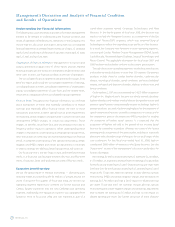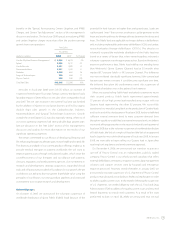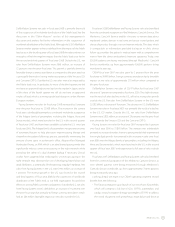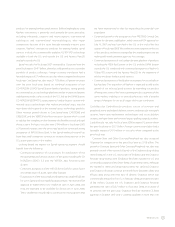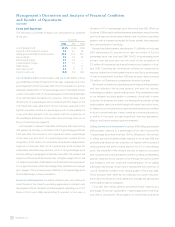Medtronic 2008 Annual Report Download - page 24
Download and view the complete annual report
Please find page 24 of the 2008 Medtronic annual report below. You can navigate through the pages in the report by either clicking on the pages listed below, or by using the keyword search tool below to find specific information within the annual report.
Management’s Discussion and Analysis of Financial Condition
and Results of Operations
(continued)
reached an agreement on a consent decree with the FDA regarding
quality system improvements for our external defibrillator products. The
agreement was filed on April 25, 2008 in the U.S. District Court for the
Western District of Washington and was approved by the court on
May 9, 2008. The agreement addresses issues raised by the FDA during
inspections regarding Physio-Control’s quality system processes and
outlines the actions Physio-Control must take in order to resume
unrestricted distribution of our external defibrillators. Following the
resolution of the quality system issues, we intend to pursue the spin-off
of Physio-Control.
Critical Accounting Estimates
We have adopted various accounting policies to prepare our
consolidated financial statements in accordance with accounting
principles generally accepted in the U.S. (U.S. GAAP). Our most
significant accounting policies are disclosed in Note 1 to the
consolidated financial statements.
The preparation of our consolidated financial statements, in
conformity with U.S. GAAP, requires us to make estimates and
assumptions that affect the amounts reported in the consolidated
financial statements and accompanying Notes. Our estimates and
assumptions, including those related to bad debts, inventories,
intangible assets, property, plant and equipment, asset impairment,
legal proceedings, IPR&D, warranty obligations, product liability,
self-insurance, pension and post-retirement obligations, stock-based
compensation, sales returns and discounts, valuation of equity and debt
securities and income tax reserves are updated as appropriate, which
in most cases is at least quarterly. We base our estimates on historical
experience, actuarial valuations or various assumptions that are believed
to be reasonable under the circumstances.
Estimates are considered to be critical if they meet both of the
following criteria: (1) the estimate requires assumptions about material
matters that are uncertain at the time the accounting estimates are
made and (2) material changes in the estimates are reasonably likely to
occur from period to period. Our critical accounting estimates include
the following:
Legal Proceedings We are involved in a number of legal actions
involving both product liability and intellectual property disputes. The
outcomes of these legal actions are not within our complete control
and may not be known for prolonged periods of time. In some actions,
the claimants seek damages as well as other relief, including injunctions
barring the sale of products that are the subject of the lawsuit, that
could require significant expenditures or result in lost revenues. In
accordance with Financial Accounting Standards Board (FASB) Statement
of Financial Accounting Standards (SFAS) No. 5, “Accounting for
Contingencies,” (SFAS No. 5) we record a liability in our consolidated
financial statements for these actions when a loss is known or
considered probable and the amount can be reasonably estimated. If
the reasonable estimate of a known or probable loss is a range, and no
amount within the range is a better estimate than any other, the
minimum amount of the range is accrued. If a loss is possible, but not
known or probable, and can be reasonably estimated, the estimated
loss or range of loss is disclosed in Note 15 to the consolidated financial
statements. In most cases, significant judgment is required to estimate
the amount and timing of a loss to be recorded. Our significant legal
proceedings are discussed in Note 15 to the consolidated financial
statements. While it is not possible to predict the outcome for most of
the matters discussed in Note 15 to the consolidated financial
statements, we believe it is possible that costs associated with them
could have a material adverse impact on our consolidated earnings,
financial position or cash flows on any one interim or annual period.
With the exception of the Cordis, Marquis and Kyphon matters, negative
outcomes for the balance of the litigation matters discussed in Note 15
to the consolidated financial statements are not considered probable
or cannot be reasonably estimated.
Tax Strategies Our effective tax rate is based on income, statutory tax
rates and tax planning opportunities available to us in the various
jurisdictions in which we operate. We establish reserves when, despite
our belief that our tax return positions are fully supportable, we believe
that certain positions are likely to be challenged and that we may or
may not prevail. These reserves are established and adjusted in
accordance with the principles of FASB Interpretation No. 48, “Accounting
for Uncertainty in Income Taxes” (FIN No. 48). Under this Interpretation,
if we determine that a tax position is more likely than not of being
sustained upon audit, based solely on the technical merits of the
position, we recognize the benefit. We measure the benefit by
determining the amount that is greater than 50 percent likely of being
realized upon settlement. We presume that all tax positions will be
examined by a taxing authority with full knowledge of all relevant
information. We regularly monitor our tax positions and FIN No. 48 tax
liabilities. We reevaluate the technical merits of our tax positions and
recognize an uncertain tax benefit, or derecognize a previously recorded
tax benefit, when (i) there is a completion of a tax audit, (ii) there is a
change in applicable tax law including a tax case or legislative guidance,
20 Medtronic, Inc.










